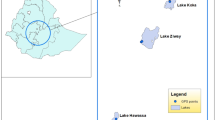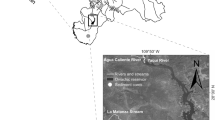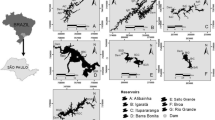Abstract
Trace metal elements (TME) can be real threats for living organisms. However, few studies dealt with TME in reservoirs in rural areas where farming practises could induce negative effects. Mae Thang reservoir (northern Thailand) has been studied for 3 years to understand the seasonal behaviour of dissolved TME: Fe, Mn, Cd, Al, Pb, V, Cr, Co, Ni, Cu, Zn, Mo, U and As and associated physicochemical parameters. In situ measurements of these parameters were done during the dry and the wet seasons as well as water samples along the water column for further analyses and TME determination by inductively coupled plasma-mass spectrometry (ICP-MS). In the dry season, the water column was characterized by a strong stratification and anoxic conditions in the hypolimnion. High rain and water input from the watershed during the wet season induced mixing of the water. All TME, except Ni, Co and Cr were less concentrated in the wet season indicating a dilution effect by water input. There was thus no important dissolved pollution coming from the watershed. The anoxic conditions in the dry season enhanced the reduction of Fe and Mn and the desorption processes. Depth, and thus oxic–anoxic conditions were the main drivers of TME in the dry season, while in the wet season, dissolution processes from parent rocks of watershed were favoured. The average concentrations of TME in the reservoir were in the limit of the international and Thai standards. Only localized values in the bottom of the reservoir for Fe and Mn were higher than the limits.






Similar content being viewed by others
References
Avila-Pérez, P., Balcázar, M., Zarazúa-Ortega, G., Barceló-Quinta, I., & Díaz-Delgado, C. (1999). Heavy metal concentrations in water and bottom sediments of a Mexican reservoir. The Science of the Total Environment, 234, 185–196.
Balistrieri, L. S., Murray, J. W., & Paul, B. (1992). The biogeochemical cycling of trace metals in the water column of lake Sammamish, Washington: response to seasonally anoxic conditions. Limnology and Oceanography, 37, 529–548.
Balistrieri, L. S., Murray, J. W., & Paul, B. (1994). The geochemical cycling of trace elements in a biogenic meromictic lake. Geochimica et Cosmochimica Acta, 58, 3993–4008.
Bonnet, M. P., & Wessen, K. (2001). ELMO, a 3-D water quality model for nutrients and chlorophyll: first application on a lacustrine ecosystem. Ecological Modelling, 141, 19–33.
Bordalo, A. A., Nilsumranchit, W., & Chalermwat, K. (2001). Water quality and uses of the Bangpakong river (eastern Thailand). Water Resources, 35, 3635–3642.
Censi, P., Spoto, S. E., Saiano, F., Sprovieri, M., Mazzola, S., Nardone, G., et al. (2006). Heavy metals in coastal water systems. A case study from the northwestern Gulf of Thailand. Chemosphere, 64, 1167–1176.
Davison, W. (1993). Iron and manganese in lakes. Earth-Science Reviews, 34, 116–163.
Elbaz-Poulichet, F., Seyler, P., Maurice-Bourgoin, L., Guyot, J. L., & Dupuy, C. (1999). Trace element geochemistry in the upper Amazon drainage basin, Bolivia. Chemical Geology, 157, 319–334.
Förstner, U., & Wittmann, G. T. W. (1979). Metal pollution in the aquatic environment. Berlin: Springer Verlag.
Foster, I. D. L., & Chalresworth, S. M. (1996). Heavy metal in the hydrological cycle: trends and explanation. Hydrological Processes, 10, 227–261.
Grellier, S. (2006). Biogeochemical study of Mae Thang reservoir (Thailand): heavy metals behaviour and thermo-biological modelling [French]. Master geosciences and civil engineering, University of Henri Poincaré, Nancy, France.
Guérin, F., Abril, G., Serça, D., Delon, C., Richard, S., Delmas, R., et al. (2006). Gas transfer velocities of CO2 and CH4 in a tropical reservoir and its river downstream. Journal of Marine Systems, 66, 161–172.
Harita, Y., Hori, T., & Sugiyama, M. (2005). Release of trace oxyanions from littoral sediments and suspended particles induced by pH increase in the epilimnion of lakes. Limnology and Oceanography, 50, 636–645.
Henry, R., & Tundisi, J. G. (1982). Evidence of limitation by molybdenum and nitrogen on the growth of the phytoplankton community of the Lobo Reservoir (Sao Paulo, Brazil). Revue d'Hydrobiologie Tropicale, 15, 201–208.
Horne, A. J., Goldman, C. R. (1994). Limnology. New York: McGraw-Hill.
Hungspreugs, M., Utoomprurkporn, W., Sompongchaiyakul, P., & Heungraksa, W. (2002). Possible impact of dam reservoirs and river diversions on material fluxes to the Gulf of Thailand. Marine Chemistry, 79, 185–191.
Islam, M. R., Lahermo, P., Salminen, R., Rojstaczer, S., & Peuraniemi, V. (2000). Lake and reservoir water quality affected by metals leaching from tropical soils, Bangladesh. Environmental Geology, 39, 1083–1089.
Janeau, J. L., Bricquet, J. P., Planchon, O., & Valentin, C. (2003). Soil crusting and infiltration on steep slopes in northern Thailand. European Journal of Soil Science, 54, 543–553.
Kruawal, K., Sacher, F., Werner, A., Müller, J., & Knepper, T. P. (2005). Chemical water quality in Thailand and its impacts on the drinking water production in Thailand. Science of the Total Environment, 340, 57–70.
Lewis, W. M. (2000). Basis for the protection and management of tropical lakes. Lakes and Reservoirs: Research and Management, 5, 35–48.
Majagi, S. H., Vijaykumar, K., & Vasanthkaumar, B. (2008). Concentration of heavy metals in Karanja reservoir, Bidar district, Karnataka, India. Environmental Monitoring and Assessment, 138, 273–279.
Mariani, C. F., & Pompêo, M. L. M. (2008). Potentially bioavailable metals in sediment from a tropical polymictic environment—Rio Grande Reservoir, Brazil. Journal of Soils and Sediments, 8, 284–288.
Michard, G., Sarazin, G., Jezequel, D., Alberic, P., & Ogier, S. (2001). Annual budget of chemical elements in an eutrophic lake, Aydat Lake, (Puy-de-Dome), France. Hydrobiologia, 459, 27–46.
Morselli, L., Barilli, L., Olivieri, P., Cecchini, M., Aromolo, R., Di Carlo, V., et al. (1999). Heavy metals determination in dry surrogate depositions. Characterization of an urban and a natural site. Annali Di Chimica, 89, 739–746.
Nagaraju, M., Gossmann, H., & Lacaze, B. (1994). Trace element geochemistry in the waters of Pulicat Lake, South India. GeoJournal, 34, 393–396.
Pertsemli, E., & Voutsa, D. (2007). Distribution of heavy metals in Lakes Doirani and Kerkini, Northern Greece. Journal of Hazardous Materials, 148, 529–537.
Petri, M. (2006). Water quality of Lake Constance. The handbook of environmental, chemistry 5, Eds Knepper T., 127–138, Springer Berlin Heidelberg DA.
Pollution Control Department of Thailand (1995). Water quality criteria and standard in Thailand. Ministry of Science, Technology and Energy.
Rai, P. K. (2009a). Heavy metals in water, sediments and wetland plants in an aquatic ecosystem of tropical industrial region, India. Environmental Monitoring and Assessment, 158, 433–457.
Rai, P. K. (2009b). Seasonal monitoring of heavy metals and physicochemical characteristics in a lentic ecosystem of subtropical industrial region, India. Environmental Monitoring and Assessment, 165, 407–433.
Reynolds, C. S. (1992). Dynamics, selection and composition of phytoplankton in relation to vertical structure in lakes. Archiv für Hydrobiologie–Beiheft Ergebnisse der Limnologie, 35, 13–31.
Rosenberg, D. M., Berkes, F., Bodaly, R. A., Hecky, R. E., Kelly, C. A., & Rudd, J. W. M. (1997). Large-scale impacts of hydroelectric development. Environmental Reviews, 5, 27–54.
Rueda, F., Moreno-Ostos, E., & Armengol, J. (2006). The residence time of river water in reservoirs. Ecological Modelling, 191, 260–274.
Seyler, P., & Elbaz-Poulichet, F. (1996). Biogeochemical control on the temporal variability of trace element concentrations in the Oubangui river (Central African Republic). Journal of Hydrology, 180, 319–332.
Seyler, P., & Martin, J. M. (1989). Biogeochemical processes affecting arsenic species distribution in a permanently stratified lake. Environmental Science, 23, 1258–1263.
Shaked, Y., Erel, Y., & Sukenik, A. (2004). The biogeochemical cycle of iron and associated elements in Lake Kinneret. Geochimica et Cosmochimica Acta, 68, 1439–1451.
Sigg, L., Kuhn, A., Xue, H. B., Kiefer, E., & Kistler, D. (1995). Cycles of trace elements (copper and zinc) in an eutrophic lake: role of speciation and sedimentation. Advances in Chemistry, 244, 177–194.
Siyue, L., Zhifang, X., Xiaoli, C., & Quanfa, Z. (2008). Dissolved trace elements and heavy metals in the Danjiangkou Reservoir, China. Environmental Geology, 55, 977–983.
Stabel, H. H., Kamperdick, P., & Sinemus, H. W. (1988). Arsengehalte im Bodenseewasser. Vom Wasser, 71, 163.
StatSoft, Inc. (2007). STATISTICA (data analysis software system), version 8.0. www.statsoft.com
Straskraba, M. (1973). Limnological basis for modelling reservoir ecosystems. In: Ackerman W.C., White F.G., Worthinton, E.B. (Eds.), Man-made lakes: their problems and environmental effects. American Geophysical Union, Washington, DC, Geophysical Monograph, 17, 517–535.
Stumm, W., & Morgan, J. J. (1981). Aquatic chemistry. New York: John Wiley Sons.
Stumm, W., & Morgan, J. J. (1996). Aquatic chemistry. New York: John Wiley Sons.
Sugiyama, M., Hori, T., Kihara, S., & Matsui, M. (2005). Geochemical behaviour of trace elements in Lake Biwa. Limnology and Oceanography, 6, 117–130.
Taillefert, M., & Gaillard, J. F. (2002). Reactive transport modelling of trace element in the water column of a stratified lake: iron cycle and metal scavenging. Journal of Hydrology, 256, 16–34.
Thiagarajan, N., & Aeolus, L. C. (2004). Trace-element evidence for the origin of desert varnish by direct aqueous atmospheric deposition. Earth and Planetary Science Letters, 224, 131–141.
Thioulouse, J., Chessel, D., Dolédec, S., & Olivier, J. M. (1997). ADE-4: a multivariate analysis and graphical display software. Statistic and Computing, 7, 75–83.
Thothong, W. (2009). Source, storage and mineralization of organic matter in a tropical water reservoir (Thailand), relationship with soil erosion on the watershed. PhD thesis, University of Pierre et Marie Curry, Paris, France.
Thothong, W., Huon, S., Janeau, J.-L., Boonsaner, A., deRouw, A., Planchon, O., et al. (2011). Impact of land use change and rainfall on sediment and carbon accumulation in a water reservoir of North Thailand. Agriculture, Ecosystems and Environment, 140, 521–533.
Tundizi, J. G., T. Matsumura-Tundizi (1990). Limnology and eutrophication of Barra Bonita reservoir, Sao Paulo State, Southern Brazil. Archiv für Hydrobiologie–Beiheft Ergebnisse der Limnologie, 33: 661-672.
Valentin, C., Agus, F., Alamban, R., Boosaner, A., Bricquet, J.-P., Chaplot, V., et al. (2008). Runoff and sediment losses from 27 upland catchments in Southeast Asia: impact of rapid land use changes and conservation practices. Agriculture, Ecosystems and Environment, 128, 225–238.
Watanabe, Y. (1992). Effects of thermal stratification on trophic linkages among plankton communities in eutrophic lakes. Archiv für Hydrobiologie–Beiheft Ergebnisse der Limnologie, 35, 1–12.
Wedepohl, K. H. (1974). Handbook of geochemistry. New York: Springer.
Wetzel, R. G. (2001). Limnology; Lake and river ecosystems. New York: Academic Press.
WHO (2004). Guidelines for drinking-water quality. 3rd ed., volume 1 — Recommendations. World Health Organisation, Geneva.
Acknowledgements
The authors thank the National Park, Wildlife and Plant Conservation Department of Thailand, the Irrigation Department of Phrae province for the logistical support, the people of the Mae Thang catchment, and reviewers for comments on the manuscript. The stay in Thailand and in Geoscience Environment Toulouse (GET) in France was supported by the Institute for Research and Development (IRD), and this study was made possible through the support of ATI U2SIS budget (IRD 2003–2006) managed by JL Guyot.
Author information
Authors and Affiliations
Corresponding author
Rights and permissions
About this article
Cite this article
Grellier, S., Janeau, J.L., Thothong, W. et al. Seasonal effect on trace metal elements behaviour in a reservoir of northern Thailand. Environ Monit Assess 185, 5523–5536 (2013). https://doi.org/10.1007/s10661-012-2964-7
Received:
Accepted:
Published:
Issue Date:
DOI: https://doi.org/10.1007/s10661-012-2964-7






